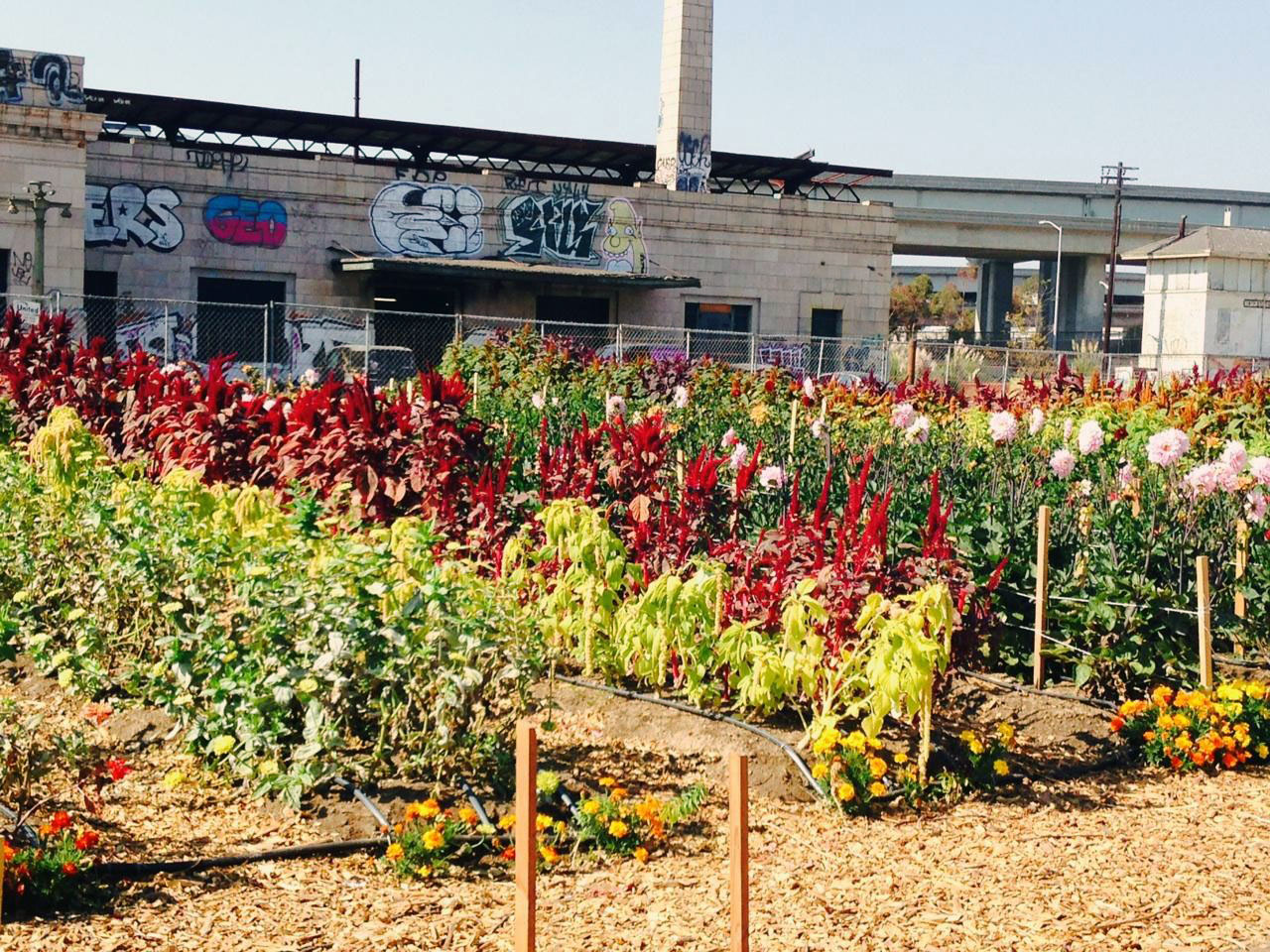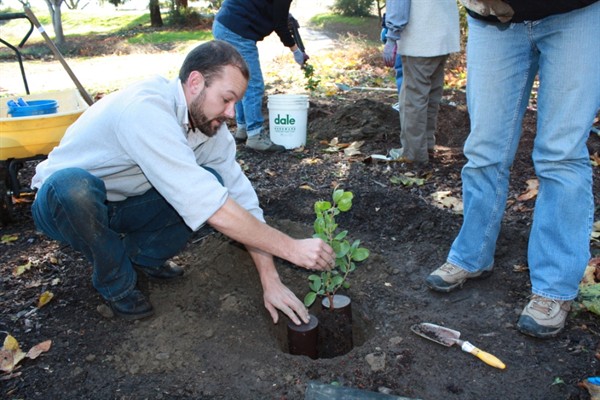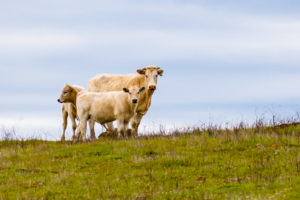What is the Healthy Soils Program?
The Healthy Soils Program provides funding to farmers and ranchers to assist with integrating soil-building management practices that also increase on-farm carbon sequestration and reduce on-farm greenhouse gas emissions from their operations. Click on the eligible practices below to learn more about the benefits of implementing healthy soil practices on farms and ranches.

- Increases organic matter in the soil, sequesters carbon, and reduces greenhouse gas emissions thus Increases land resiliency to projected climate changes
- Provides slow-release nutrients, resulting in enhanced plant growth and healthier, more reliable harvests and increased yields
- Lowers the soil pH, which allows for greater nutrient bioavailability
- Increases water holding capacity and infiltration, thus reducing water costs and helping to protect against crop loss in times of water shortages
- Increases soil organism abundance and diversity, which moves the system towards a more beneficial fungal community that acts as a glue holding the soil together, this reduces soil erosion and subsequent soil loss, lowering long-term maintenance costs
- Increases the soil’s ability to hold onto nutrients, allowing more fertilizers to stay on-site, thus lowering costs associated with fertilizer additions
- Improves soil tilth, health, structure, and reduces soil compaction allowing for healthier, deeper plant root development

- Plant cover protects the soil like a blanket, reducing wind and water erosion, sequestering carbon, and reducing greenhouse gas emissions, which lowers long-term maintenance costs
- Intentional planted cover outcompetes less desirable plant species, increases species diversity, and acts as habitat and food sources for beneficial organisms, reducing pest control inputs and increasing pollination services
- Plants hold nutrients in their biomass which is released when they’re mowed or tilled under, specifically legume species that work with microbes to pull nitrogen from the air into the plant biomass, reducing fertilizer inputs
- Plant roots improve soil health by increasing organic matter and breaking through tough soil layers, thus reducing tractor tillage that leads to soil structure breakdown and loss
- Plant roots and subsequent increased organic matter also allow for improved water infiltration and water holding capacity, thus reducing water costs and helping to protect against crop loss in times of water shortages
- Increased plant density reduces nutrient leaching, allowing more fertilizers to stay on-site and lowering costs associated with fertilization inputs

- Trees and plants act as a wind block, improving air quality, and reducing erosion and chemical spray drift from surrounding fields
- Trees and plants provide habitat and food sources for beneficial microbes, insects, and birds, reducing pest control inputs while increasing pollination and fertilization services
- Mulch and plant roots filter and hold onto nutrients, allowing more fertilizers to stay on-site, thus improving surrounding water quality and lowering costs associated with fertilizer inputs
- Trees and plants beautify and increase aesthetic farm value
- Mulch increases soil organism abundance and diversity, which moves the system towards a more beneficial fungal community that holds the soil together and reduces root rot causing organisms

- Protects the soil like a blanket, suppressing weeds and reducing wind and water erosion, which lowers long-term maintenance costs
- Increases organic matter in the soil, sequesters carbon, and reduces greenhouse gas emissions, thus increasing land resiliency to projected climate changes
- Provides slow-release nutrients, resulting in enhanced plant growth and healthier, more reliable harvests and increased yields
- Acts as a filter and holds onto nutrients, allowing more fertilizers to stay on-site, thus improving water quality and lowering costs associated with fertilizer inputs
- Reduces soil compaction and allows for vehicle access after heavy rainfalls
- Keeps produce cleaner while beautifying and increasing aesthetic farm value
- Lowers the soil pH, which allows for greater nutrient bioavailability
- Increases water holding capacity and infiltration, thus reducing water costs and helping to protect against crop loss in times of water shortages
- Increases soil organism abundance and diversity, which moves the system towards a more beneficial fungal community that holds the soil together and reduces root rot causing organisms
- Improves soil tilth, health, structure, and reduces soil compaction allowing for healthier, deeper plant root development

- Trees and plants act as a wind block, improving air quality, and reducing erosion and chemical spray drift from surrounding fields
- Trees and plants provide habitat and food sources for beneficial microbes, insects, and birds, reducing pest control inputs while increasing pollination and fertilization services
- Plant roots filter and hold onto nutrients allowing more fertilizers to stay on-site, thus improving water quality and lowering costs associated with fertilizer inputs
- Trees and plants beautify and increase aesthetic farm value
- Mulch increases soil organism abundance and diversity, which moves the system towards a more beneficial fungal community that holds the soil together and reduces root rot causing organisms
- Increases shade and shelter for stock, pasture, and crops, leading to improved stock health, birthing rates, and crop production
- Increases and diversifies income streams

- Trees and plants provide habitat and food sources for beneficial microbes, insects, and birds, reducing pest control inputs while increasing pollination and fertilization services
- Plant roots filter and hold onto nutrients, allowing more fertilizers to stay on-site, thus improving water quality and lowering costs associated with fertilizer inputs
- Plant roots help to stabilize streambanks, slowing out-of-bank flood flows while protecting croplands from flooding
- Buffer zones reduce erosion and siltation of stream and pond banks, improve groundwater flow into reservoirs, and prevent clogging of irrigation
- Trees and plants beautify and increase aesthetic farm value
- Provides shade and reduces evaporative water loss
- Increases and diversifies income streams
- Reduces tractor passes and resulting fuel use and labor costs
- Reduces organic matter loss, sequesters carbon, and reduces greenhouse gas emissions, which increases land resiliency to projected climate changes
- Increases water holding capacity and infiltration, thus reducing water costs and helping to protect against crop loss in times of water shortages
- Protects soil organism abundance and diversity, which moves the system towards a more beneficial fungal community that acts as a glue holding the soil together
- Increases the soil’s ability to hold onto nutrients, allowing more fertilizers to stay on-site, thus lowering costs associated with fertilizer additions
- Reduces soil erosion and subsequent soil loss, lowering long-term maintenance costs
- Improves soil tilth, health, structure, and reduces soil compaction allowing for healthier, deeper plant root development
- Encourages increased plant cover and deep root establishment that protects the soil from wind and water erosion, sequesters carbon, and reduces greenhouse gas emissions, which increase land resiliency to projected climate changes
- Improves soil tilth, health, structure, and reduces soil compaction allowing for lower long-term maintenance costs
- Animal droppings serve as natural fertilizer while deep plant roots filter and hold onto these nutrients, this allows for more nutrients to stay on-site, thus improving water quality and lowering costs associated with fertilizer inputs
- Intentional planted cover outcompetes less desirable plant species, increases species diversity, forage quality and quantity, and acts as habitat and food sources for beneficial organisms, reducing pest control inputs and increasing pollination services

- Intentional planted cover outcompetes less desirable plant species, increases species diversity, increases forage quality and quantity, and acts as habitat and food sources for beneficial organisms, reducing pest control inputs and increasing pollination services
- Encourages increased plant cover and deep root establishment that protects the soil from wind and water erosion, sequesters carbon, and reduces greenhouse gas emissions, which increase land resiliency to projected climate changes
- Improves soil tilth, health, structure, and reduces soil compaction allowing for lower long-term maintenance costs
- Wildflowers and native grasses beautify and increase aesthetic farm value
- Trees act as a wind block, improving air quality, and reducing erosion and chemical spray drift from surrounding fields
- Trees and plants provide habitat and food sources for beneficial microbes, insects, and birds, reducing pest control inputs while increasing pollination and fertilization services
- Plant roots filter and hold onto nutrients, allowing more fertilizers to stay on-site, thus improving water quality and lowering costs associated with fertilizer inputs
- Trees and plants beautify and increase aesthetic farm value
- Plant cover increases soil organism abundance and diversity, which moves the system towards a more beneficial fungal community that holds the soil together
- Trees increase shade and shelter for stock, pasture, and cool season forage plants, leading to improved stock health, birthing rates, and crop production
- Increases and diversifies income streams
- Increases organic matter in the soil, sequesters carbon, and reduces greenhouse gas emissions thus Increases land resiliency to projected climate changes
- Increases water holding capacity and infiltration, thus reducing water costs and helping to protect against crop loss in times of water shortages
- Increases soil organism abundance and diversity, which moves the system towards a more beneficial fungal community that acts as a glue holding the soil together
- Increases the soil’s ability to hold onto nutrients, allowing more fertilizers to stay on-site, thus lowering costs associated with fertilizer additions
- Reduces soil erosion and subsequent soil loss, lowering long-term maintenance costs
- Improves soil tilth, health, structure, and reduces soil compaction allowing for healthier, deeper plant root development
- Trees and plants act as a wind block, improving air quality, and reducing erosion and chemical spray drift from surrounding fields
- Trees and plants provide habitat and food sources for beneficial microbes, insects, and birds, reducing pest control inputs while increasing pollination and fertilization services
- Plant roots filter and hold onto nutrients, allowing more fertilizers to stay on-site, thus improving water quality and lowering costs associated with fertilizer inputs
- Trees and plants beautify and increase aesthetic farm value
- Mulch increases soil organism abundance and diversity, which moves the system towards a more beneficial fungal community that holds the soil together and reduces root rot causing organisms
- Increases shade and shelter for stock, pasture, and crops, leading to improved stock health, birthing rates, and crop production
- Increases and diversifies income streams
- Selecting the right fertilization product, the right amount, and the right time and place to match plant needs, increases farming profitability and minimizes nutrient losses to the environment
- Keeping nutrients on site can reduce or eliminate excessive algae growth and subsequent loss of fish populations and resulting odors in nearby waterbodies
- Overuse of fertilizers can lead to excessive metals and other unwanted contaminants in the soil/plants
- Excessive water nitrogen concentrations can cause health problems for horses & ruminants
- Reduces costs associated with debris removal or permits for burning on site
- Protects the soil like a blanket, suppressing weeds and reducing wind and water erosion, which lowers long-term maintenance costs
- Increases organic matter in the soil, sequesters carbon, and reduces greenhouse gas emissions, thus increasing land resiliency to projected climate changes
- Provides slow-release nutrients, resulting in enhanced plant growth and healthier, more reliable harvests and increased yields
- Acts as a filter and holds onto nutrients, allowing more fertilizers to stay on-site, thus improving water quality and lowering costs associated with fertilizer inputs
- Reduces soil compaction and allows for vehicle access after heavy rainfalls
- Keeps produce cleaner while beautifying and increasing aesthetic farm value
- Lowers the soil pH, which allows for greater nutrient bioavailability
- Increases water holding capacity and infiltration, thus reducing water costs and helping to protect against crop loss in times of water shortages
- Increases soil organism abundance and diversity, which moves the system towards a more beneficial fungal community that holds the soil together and reduces root rot causing organisms
- Improves soil tilth, health, structure, and reduces soil compaction allowing for healthier, deeper plant root development
- Increased shoot growth after the 2nd year and increased tree circumference after 4th year, resulting in less bud failure, with increased yields and productivity
- Intentional planted cover outcompetes less desirable plant species, increases species diversity, increases forage quality and quantity, and acts as habitat and food sources for beneficial organisms, reducing pest control inputs and increasing pollination services
- Encourages increased plant cover and deep root establishment that protects the soil from wind and water erosion, sequesters carbon, and reduces greenhouse gas emissions, which increase land resiliency to projected climate changes
- Improves soil tilth, health, structure, and reduces soil compaction allowing for lower long-term maintenance costs
- Animal droppings serve as natural fertilizer while deep plant roots filter and hold onto these nutrients, this allows for more nutrients to stay on-site, thus improving water quality and lowering costs associated with fertilizer inputs
- Increases water holding capacity and infiltration, thus reducing water costs and helping to protect against crop loss in times of water shortages
- Increases soil organism abundance and diversity, which moves the system towards a more beneficial fungal community that acts as a glue holding the soil together
- Increases food diversity and abundance for stock during periods of low forage production, leading to improved stock nutrition and health
- Increases and diversifies income streams
- Planted boarders protect the soil like a blanket, reducing wind and water erosion, sequestering carbon, and reducing greenhouse gas emissions, which lowers long-term maintenance costs
- Intentional planted cover outcompetes less desirable plant species, increases species diversity, and acts as habitat and food sources for beneficial organisms, reducing pest control inputs and increasing pollination services
- Plants hold nutrients in their biomass which is released when they’re mowed or tilled under, specifically legume species that work with microbes to pull nitrogen from the air into the plant biomass, reducing fertilizer inputs
- Boarder strips of grasses and legumes can be used for forage or harvested at the end of the season
- Reduces nutrient leaching, allowing more fertilizers to stay on-site, improving water quality and lowering costs associated with fertilization inputs
- Provides a turning point for farm equipment
- Can beautify and increase aesthetic farm value
- Intentional planted cover outcompetes less desirable plant species, increases species diversity, provides habitat and food sources for beneficial microbes, insects, and birds, reducing pest control inputs while increasing pollination and fertilization services
- Encourages increased plant cover and deep root establishment that protects the soil from wind and water erosion, sequesters carbon, and reduces greenhouse gas emissions, which increase land resiliency to projected climate changes
- Improves soil tilth, health, structure, and reduces soil compaction allowing for lower long-term maintenance costs
- Animal droppings serve as natural fertilizer while deep plant roots filter and hold onto these nutrients, this allows for more nutrients to stay on-site, thus improving water quality and lowering costs associated with fertilizer inputs
- Increases water holding capacity and infiltration, thus reducing water costs and helping to protect against crop loss in times of water shortages
- Increases soil organism abundance and diversity, which moves the system towards a more beneficial fungal community that acts as a glue holding the soil together
- Wildflowers and native grasses beautify and increase aesthetic farm value
- Encourages deep roots that reduce erosion and subsequent downstream sedimentation and siltation of stream and pond banks
Check out The Soil Awakens, a new video on the amazing soil life all around us. It provides great context for the work ACRCD does in our Carbon Farming, Healthy Soils, and Urban Agriculture programs, to name a few.
This video, and the products to follow, were produced under a UC Davis/USDA-NRCS collaborative project and are part of a national campaign to raise awareness about the value and importance of soil. It has been followed with a short animated video series and an interactive website, including a graphics-based intro to soil science, a media hub of vetted soils-related content, and clear, actionable items for people to ‘get involved’ with protecting and promoting soils in their everyday lives.
Videos will be shared as they are released. If you are on social media, you can find and connect on Instagram @soil.life – Facebook @TheSoilLife – and Twitter @The_Soil_Life.
Technical Assistance
If you are interested in the Healthy Soils Incentives Program, please reach out to ACRCD for:
- More information about the Healthy Soils Program
- Review your project ideas or answer any questions
- Application assistance
- Help you with implementation, monitoring, and reporting after grant awards are received
